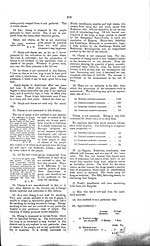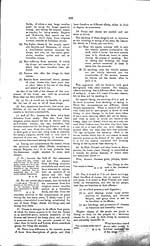Medicine - Drugs > Report of the Indian Hemp Drugs Commission, 1894-1895 > Volume IV
(218) Volume 4, Page 204
Thumbnail gallery: Grid view | List view

204
29. The following is a
list of the ingredients
used with bhang:—
|
When used. |
Name of
ingredients |
REMARKS. |
|
Used ordinarily
by |
I.—Bhang with
black- |
It is called |
|
Bhang with
black-pep- |
It is called |
|
|
Sugar is
sometimes |
||
|
Used ordinarily
by |
II.—Bhang with
black- |
This is
called |
|
Sugar is
sometimes |
||
|
Used by rich
people |
III.—Rich people
pre- |
This is also
call- |
|
Sugar is
sometimes |
||
|
Used by rich
people |
Bhang, clove,
saffron, |
This is also |
|
Used on special
oc- |
Bhang, curd,
salt, |
This is
called |
|
Bhang, milk,
sugar, |
This is
called |
Besides these, the drug
is consumed in several
other ways:—
Bhang pua (pancake).
Bhang-ka-pakouri (a kind
of dish made of
bhang and pea meal).
Bhang-ka-majun (confection), etc.
30. Bhang is
consumed in solitude 12/16
Bhang is consumed in company
4/16
Ganja smoked in solitude
6/16
Ganja smoked in
company
10/16
The use of bhang and
ganja is mainly confined
to the male sex. Children are not allowed to
contract the habit of consuming the drugs, es-
pecially ganja.
31. The habit of
consuming any of these drugs
is not easily formed but by long and constant use
of them. Such habit when once formed, specially
that of ganja or charas-smoking, it is difficult to
break off. From daily observance as also from the
In some cases there
cer-
tainly is.
H. C. W.
statistics ralating to
the consumption of ganja I
can say there is no ten-
dency in the case of ganja
for the moderate habit
to develop into excessive.
Bhang is not much
consumed, and charas not at
all.
32. The followers of
"Agam Marg" or "Brah-
machári" according to "Samaya Char Tantra Shas-
tra" offer bhang to "Siva" and "Parbati" at the
time of their worship. To "Biswanath" at
Kashi or Benares and to Baldaoji in Brindaban
(Hindu deities) bhang drinks are offered daily.
Ganja and bhang are offered to Siva and Bairava
at Benares and elsewhere. The use of the drugs
at the worship of the deities mentioned above is
regarded as essential. A sect of Muhammadan
ascetics offer ganja to their Malang. The use of
the drugs on such occasions as stated above is
generally temperate. It is not likely to lead to
the formation of the habit, nor is otherwise inju-
rious. There are, however, some exceptional
cases. The bhang offered to Baldaoji in Brinda-
ban is used by the Pandás there, who and the
Chowbays of Mathra are intemperate drinkers.
33. The
consumption of these drugs is regarded
according to the different circumstances of the
consumers. A mendicant or an ascetic, though
an excessive consumer, is still respectfully regard-
ed; while a house-holder, or a student found in
that habit, is looked upon with contempt and still
more so if he associates with bad people. One
using the drug moderately as a remedy for any
disease or as a preventive of it or for alleviating
fatigue is not disrespected. The moderate use of it
by persons in easy circumstances or by big people
is also not noticed. But special care is taken by
all classes of the people that their children do
not get into the habit of using the drugs, speci-
ally ganja; and still more so as regards charas,
and this is so done with a precaution that the
habit might not develop into excessive use
of them and then they might be looked down
by the society with contempt as "Bhangeri"
and "Ganjeris." In Behar, as far as my ex-
perience goes, men of good family take care that
the children do not get into the habit of using
any kind of intoxicant, and this is the reason
why in many families the use of any kind of
stimulant is considered a vice, specially that of
spirit and tari.
I do not know any custom
in which the hemp
plant is worshipped by any sect of the people;
but I can say this much that as it is offered to
Siva (for which reason it is called also Shewji-ka-
buti), the drink or the drug is respectfully
regarded and not scorned as tari or sharab.
34. Yes; it
would be a serious privation to
several classes of the consumers to forego the
consumption, if any, of the drugs they use,
viz.:—
(1) Bairagis,
sanyasis aad other Hindu fakirs
who live in every district
and travel
throughout the country and in all cli-
mates (an idea of the numerical
strength of which body can be well
formed on the occasion when they
periodically assemble at Pryag, Hard-
wár, and other sacred places of the
Hindus), and who, with a few ex-
ceptions, are all consumers of the
drug.
(2) The Hindu
sepoys in Government service
and of Rájas and zamindars
in British
Set display mode to: Large image | Zoom image | Transcription
Images and transcriptions on this page, including medium image downloads, may be used under the Creative Commons Attribution 4.0 International Licence unless otherwise stated. ![]()
| India Papers > Medicine - Drugs > Report of the Indian Hemp Drugs Commission, 1894-1895 > Volume IV > (218) Volume 4, Page 204 |
|---|
| Permanent URL | https://digital.nls.uk/74552686 |
|---|---|
| Description | Evidence of Bengal witnesses. |
| Description | Volume 4: Evidence of witnesses from Bengal and Assam. |
|---|---|
| Attribution and copyright: |
|




